Episode 148: STS-74 - Putting out the Welcome Mat (Mir Docking Module)
Table of Contents
We’ve docked at Mir before, but moving the Kristall module around is such a hassle. What if we could just make it a little longer so the shuttle could dock with it in its usual location? Also, please don’t keep your ice cream next to the blood and urine samples.
Episode Audio #
Photos #
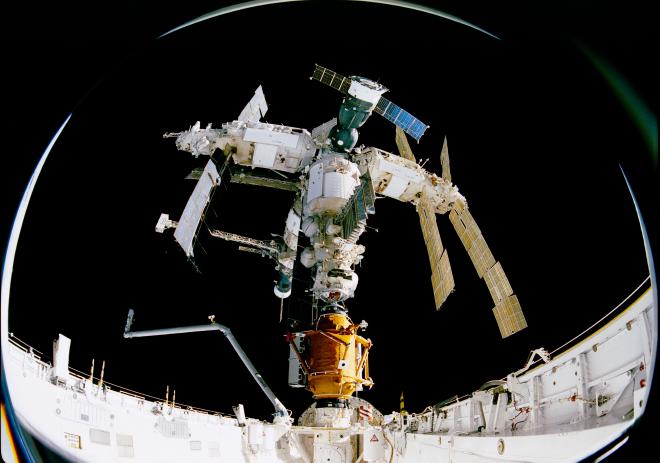
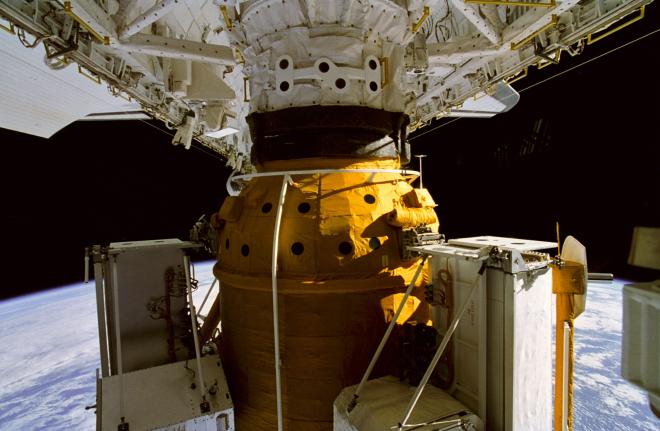
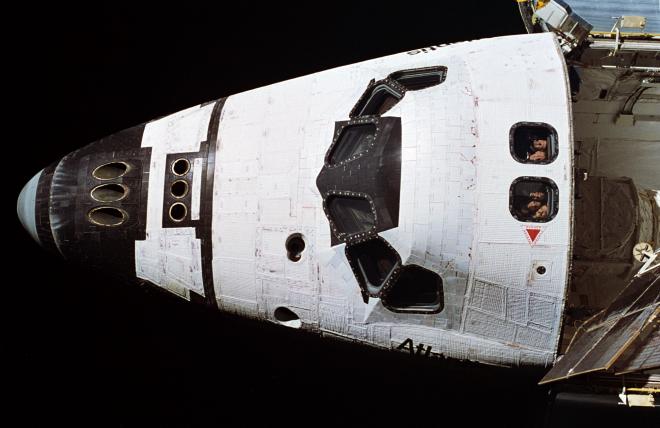
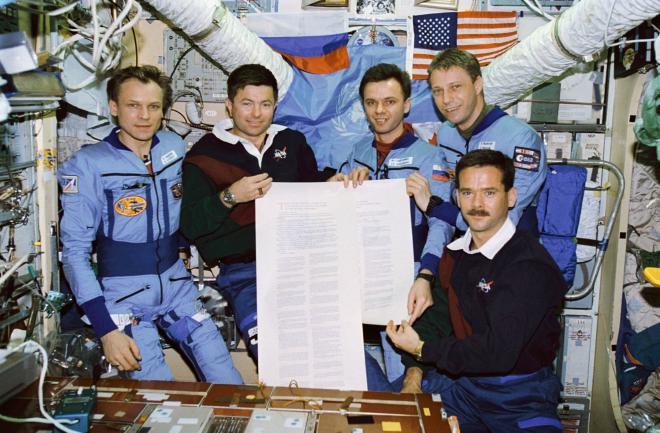
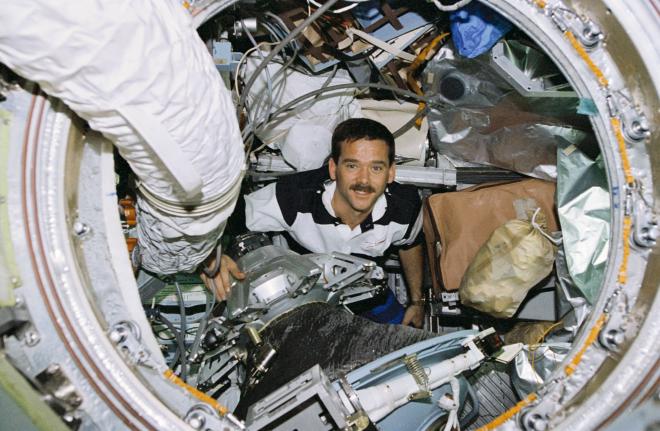
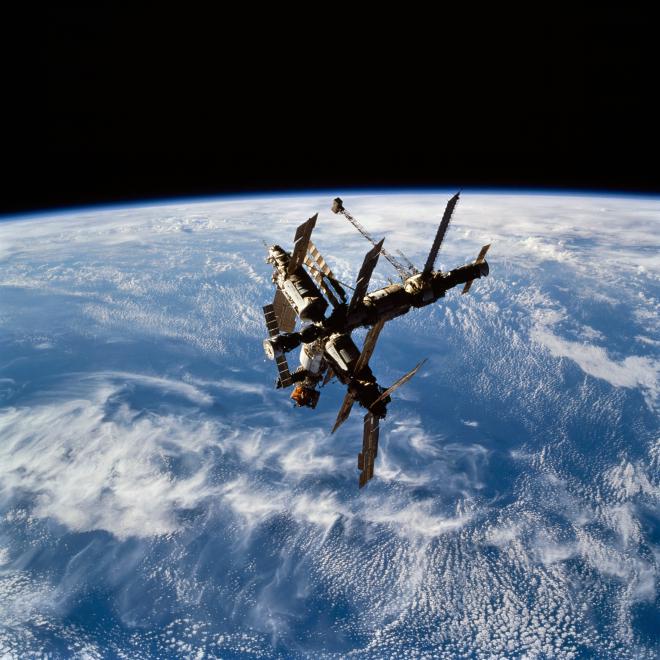
For more photos, head over to our friends at Wikiarchives.space: https://wikiarchives.space/index.php?/category/868
Post-Flight Presentation #
If you’d like to see the mission in motion you can check out the post-flight presentation here:
Transcript #
NOTE: This transcript was made by me just copying and pasting the script that I read to make the podcast. I often tweak the phrasing on the fly and then forget to update the script, so this is not guaranteed to align perfectly with the episode audio, but it should be pretty close. Also, since these are really only intended to be read by myself, I might use some funky punctuation to help remind myself how I want a sentence to flow, so don’t look to these as a grammar reference. If you notice any egregious transcription errors or notes to myself that I neglected to remove, feel free to let me know and I’ll fix it.
Hello, and welcome to The Space Above Us. Episode 148. Space Shuttle flight 73, STS-74: Putting out the welcome mat
Very quickly here at the top I wanted to let you know that there is now a The Space Above Us store!: store.thespaceabove.us. If you’ve ever wanted to get the The Space Above Us logo on a t-shirt, hoodie, mug, or sticker, now is your chance. For some reason there are also like four different types of shirts and some funny stuff like a throw pillow. If anyone actually gets that pillow, I want to see a picture. So if you want to trick people into asking “what’s that thing on your shirt” so you can get another chance to rant about space, just head over to store.thespacebove.us.
Last time, we talked about STS-73, which after six scrubbed attempts, finally made it into orbit on its seventh try. It was well worth the wait for the crew of seven, including five spaceflight rookies. During their nearly 16 days on orbit, the crew split into two shifts and worked around the clock to advance humanity’s knowledge on fields as diverse as fluid mechanics, weightless combustion, and of course, protein crystals.
Today’s flight is going to be considerably lighter on science, but will unlock the door to years of science to come. We’re going to give Mir a welcome mat.
As we’ve learned on this show, approaching and docking with a space station isn’t as straightforward as it looks– not that it really looked all that straightforward to begin with. There are lots of considerations to be made for which direction to approach from, what sort of attitude mode the spacecraft and station need to be in, communications windows, lighting conditions, plume impingement, and so on. But I bet one that you never really considered before was that for STS-71, the Russian crew of Mir had to literally transform their space station. In order to allow the orbiter, with its giant wings and tail, to safely approach the clusters of solar arrays, booms, and antennas on Mir, the Kristall module had to be moved from a radial location to one that was in line with the main axis of the station. Thanks to some really nifty mechanisms thought up by the Russians, this was doable, but it was a hassle. While in that configuration, they couldn’t accommodate a supply ship, which I believe was also how they would typically change Mir’s orbit. So every time the shuttle arrived, they would have to do this complicated maneuver where they moved modules around. And while I have no reason to doubt the mechanism, I’m sure there was plenty that could go wrong, potentially leading to the station being stuck in an undesirable or unworkable configuration. Plus it was just a hassle.
Things would be much easier if the shuttle could just dock on one of the radial ports. Unfortunately, with the placement of the solar arrays and the dimensions of the orbiter, there was just no way to make that work.. or was there??
The solution was (da-da-da-daaa) the docking module. We haven’t seen a good docking module since the Apollo-Soyuz Test Project! Well, I mean, this is only the second one we’ve seen ever, and I’m pretty sure it’s the last one, but who’s counting. The docking module was essentially a little vestibule or foyer or front room or whatever that could be stuck onto the end of the Kristall module, making it slightly longer. With the added room, the shuttle could dock with Mir while Kristall remained in its regular position.
As you might imagine, sticking an extra room onto a Russian space station is a little more involved than that, but we’ll save the details for orbit. Let’s meet the crew!
Commanding this mission was Ken Cameron, who we last saw commanding STS-56, the ATLAS-2 flight. This is Cameron’s third and final mission, but with it, he’ll help make things a little easier for the crews of all future Shuttle-Mir missions.
Flying alongside Cameron up front was Jim Halsell. When we last saw Jim Halsell, it was on STS-65, the International Microgravity Laboratory 2 flight. And as I will remind you whenever STS-65 comes up (just cause I think it’s so funny), that mission’s commander Bob Cabana wrapped the IML flag around himself and flew across Spacelab, declaring himself to be IML-Man. With this flight, Halsell marks his second of five missions.
Sitting behind Halsell for ascent was someone who I suspect will be very familiar to most listeners of this podcast: Mission Specialist 1, Chris Hadfield. Chris Hadfield was born on August 29th, 1959 in the city of Sarnia located in Ontario, Canada, but he grew up in Milton, a suburb of Toronto. Hadfield got a taste for flight early in life, learning how to fly gliders when he was only 15 years old, and powered aircraft the year after that. He graduated from the Royal Military College in Kingston, Ontario with a Bachelor’s in Mechanical Engineering. After that he enlisted in the Canadian Armed Forces where he learned how to fly jets. He worked in a variety of roles, including performing the first intercept of a Soviet “Bear” aircraft in a CF-18 fighter jet. Eventually he discovered test piloting and graduated from test pilot school at Edwards Air Force Base and worked at the Patuxent River Naval Air Station in Maryland as an exchange officer. While in Maryland, the chance to achieve a childhood dream emerged when it was announced that Canada was looking for a second batch of astronauts. Hadfield applied, and in 1992 was selected to wear the red maple leaf into orbit. This is his first of three flights.
Sitting to Hadfield’s left was one of our frequent flyers, Mission Specialist 2, Jerry Ross. When we last saw Ross, he was helping perform science on the second German-funded Spacelab mission, STS-55. But before that, he flew as Mission Specialist 2 on STS-37, the Gamma Ray Observatory mission. That flight was piloted by none other than Ken Cameron. Cameron liked Ross in the flight engineer role so much that he specifically requested him for this mission, and here he is on this, his fifth of seven flights.
And last but not least, with the entire middeck to himself on ascent, was Mission Specialist 3, Bill McArthur. When we last saw McArthur, it was on STS-58, a Spacelab mission jam-packed with life sciences studies where we said the word “otolith” a lot. While I’m sure he’s proud of his scientific contributions, I’d bet that Bill is glad that on this flight he’ll be looking out the window more and looking at rats less. This is his second of four flights.
The payload that the crew of STS-74 would be delivering into orbit was somewhat unusual in that only two years earlier it wasn’t even on the drawing board. Typically, space hardware can take years, and even decades to design, validate, construct, test, and prepare for launch. Since the Shuttle-Mir program would only last a couple of years it was necessary to move quite a bit faster than that. After all, while we call it the Shuttle-Mir program here, it’s more properly known as Phase One of the International Space Station. The whole point was to quickly learn some lessons and get some practice in before work began in earnest on the ISS. So delivering it in 2005 or something would not be very helpful.
So with that in mind, our partners in the east got moving.. fast. They began design work on the Docking Module in November of 1993. They began assembly in February of 1995, which lasted all of three months before it was completed. Including testing. A month after that a Russian cargo plane landed at the Shuttle Landing Facility, delivering the Docking Module to the Kennedy Space Center. If you look at the entire process, the Docking Module went from not even existing in anyone’s head to being space hardware installed on Mir in only two years. That’s pretty remarkable.
The Docking Module also proved to be a convenient way to further enhance the Russian space station. Because in addition to providing additional clearance to arriving shuttles, it was a good place to stick a couple of solar arrays. One set was made by Russia and one set was made by the United States. After the shuttle departed, the cosmonauts would go on a spacewalk and move them to a permanent location. Again, not bad for only two years!
So what did they actually make in those two years? The Docking Module was essentially just a metal cylinder, covered in an orange outer layer, and with two APAS docking adapters on either end. APAS, again, stood for the Androgynous Peripheral Attach System and was a standardized docking mechanism used by both the United States and Russia for joint operations. The structure was 4.7 meters long, 2.2 meters in diameter, and about 4000 kilograms. And for the metrically challenged out there, that’s about 15 feet long, 7 feet wide, and about 9000 pounds. As a human-scale comparison, I sort of think of it like a chunky mini-van.
Though since we’re space nerds, we don’t have to compare it to a mini-van, we can compare it to something else.. the Apollo-Soyuz Test Project docking adapter! Other than notable difference of not involving Deke Slayton at all, the Mir Docking Adapter was 50% longer, about 60% wider, and was more than twice as heavy as the the ASTP one. Though to be fair, the space shuttle and Mir are a bit bigger than Apollo and Soyuz.
The launch was scheduled for a nice reasonable liftoff time of around 8 AM, but thanks to their orbital destination, the time in Florida didn’t matter to the crew as much as the time in Moscow. Since the Mir crew were synced up with Moscow, and the orbiter crew wanted to be synced up with the Mir crew, they shifted their sleep schedule during the buildup to the launch. When they arrived at the Kennedy Space Center, the entire crew wore dark glasses in an attempt to prevent the bright sunlight from undoing all of their hard work.
Well, it turned out that they would get one more day to continue to adapt to Moscow time since when the clock hit the scheduled launch time, all was quiet at Launchpad 39-A. While the weather in Florida had cooperated for once, the weather at the trans-Atlantic abort sites was unacceptable and there was no choice but to scrub the launch.
The next day, the crew once again climbed aboard the Astrovan, made their way up the launchpad elevator, scooted through the hatch, and strapped in for the ultimate thrill ride. This time the weather cooperated everywhere, and On November 12th, 1995, at 7:30 and 43 seconds AM Eastern Standard Time, Space Shuttle Atlantis once again leapt off the pad and set its sites on Mir. The ascent was essentially uneventful, but since I always say that, I’ll expand a little and tell you the sort of details I normally skip. Until the payload bay doors are opened and the radiators are exposed to space, the orbiter cools itself by using water boilers. During the ride uphill, two of the water spray boilers got a little cooler than expected, which required some heaters to kick in. See? I told you. Uneventful.
Once on orbit, the crew began phasing, catching up with Mir a little more with each trip around the world.
If you were to have watched this mission unfold in realtime you perhaps would have been surprised to discover that there really wasn’t much information being released by NASA. The usual flurry of press updates and now webpage bulletins dried up, leaving the public to wonder what exactly was going on. No, it wasn’t secretly a classified mission, and no, NASA wasn’t hiding some unfolding disaster. Instead, the unfolding disaster was happening about 2000 kilometers northeast of Houston in Washington, DC.
You’ll have to find some other podcast to fill in the finer details, but in the nation’s capital, disagreements over the federal budget had escalated to the point that the government ran out of money. With no other choice, all non-essential federal personnel were sent home. So that’s why two days after liftoff, with the public affairs officers pacing around their living rooms at home, coverage suddenly got a little light.
Of course, the mission controllers at the Johnson Space Center counted as essential personnel, so continued to work, but the whole situation added some unnecessary stress to an already eventful week. That said, leave it to astronauts and their accomplices on the ground to add a little levity to a tough situation. While there were no official press releases, someone was maintaining a quote “Utterly Unofficial” mission status webpage for folks to enjoy. There was even a Canadian version just for the people looking for updates on Chris Hadfield. I’m not sure what made the Canadian version any different, but given that this was a webpage in the 1995, I’m betting there were some animated gifs of hockey sticks or something. (Once again needlessly antagonizing Canadians..)
Also, presumably since the whole situation was a little embarrassing, the crew were asked to not ask about the status of the shutdown over the air to ground radio. Instead, they asked “How’s the parking today?” When CAPCOM Story Musgrave reported that “the parking is still real good” the crew knew the shutdown was still in effect.
The whole thing was a hassle, but the mission was largely unaffected. Though the government wasn’t the only thing that wasn’t working. TIPS, the Thermal Impulse Printer System, and the successor to our old friend TAGS, and was encountering some trouble. While running on the usual Ku-band signal routed through TDRSS, printed pages were missing lines. The crew tried switching to S-band, only to discover that they completely lost the ability to print any graphics, only text. It’s the ghost of TAGS fighting back! After more investigation, it turned out that problem was on the ground, so I guess we can’t give TIPS too hard of a time.
On flight day three it was time to perform the first big operation of the mission. The reason that the Docking Module had an APAS docking system on both ends was that one end would be permanently attached to Mir, while the other would be the site of future Shuttle dockings. To get it there in the first place, the plan was to attach the Docking Module to the top of the Orbiter Docking System in the payload bay, essentially creating a weird tall docking adapter. The Atlantis crew would then dock to Mir in this configuration, but when they left, would disengage the APAS that connected Atlantis and the Docking Module, leaving it behind on Mir.
Well that’s all great but how are we going to get the DM onto the ODS in the first place? The Docking Module was in the back of the payload bay, while the Orbiter Docking System was at the front, attached to the airlock. Stand aside, Americans. This.. was a job for a Canadian!
Specifically, Chris Hadfield would become the first Canadian to operate the Canadian-made remote manipulator system, also known as the Canadarm. It would be his job to ensure that the docking module was safely installed atop the orbiter docking system.
Without pulling this off, there would be no mission, and as we’ve learned, it’s best not to take anything for granted. So just in case the system wouldn’t connect, the cabin had been depressurized down to 10.2psi, which would expedite a contingency EVA. So while Jerry Ross and Bill McArthur surely had full confidence in Chris Hadfield’s ability to complete his job successfully, I bet some part of them was hoping for juuust enough of a problem to warrant them piling into the airlock and heading outside.
Operating the RMS controls at the back of the flight deck, Hadfield reached out and grappled the Docking Module, raising it up out of the payload bay. He then rotated it to an upright position turned it around to the proper alignment, and began moving it closer to the crew cabin until it was positioned just a few inches directly above the orbiter docking system. Hadfield was able to do this with precision thanks to a clever camera system that had been attached to the Orbiter Docking System. By using his view out the window, the view from the elbow camera on the arm, and the precise view of the camera looking directly up from the ODS, Hadfield knew that he was perfectly in position. There was only one problem. The robot arm was attached to the shuttle at the front of the payload bay, up near the crew cabin, but so was the ODS. That meant that in order to move the end of the arm to the front, it had to basically fold in half, creating a tight angle with the elbow. With this tight elbow angle, the arm didn’t have enough power to force the docking mechanisms on the DM and ODS to connect. So instead, Hadfield commanded the arm to just relaaax.
Specifically, he disabled all the braking motors, essentially making the arm go limp. At that moment, Commander Cameron fired six downward-facing RSC thrusters, causing the orbiter to jump “up” from their point of view. Since the arm was limp, the docking module stayed in place as the orbiter essentially ran it over, forcing the docking mechanism to engage. It’s a pretty neat trick.
If you’re curious what Ross and McArthur would have done to force the two pieces of hardware together, the answer wasn’t to use their super strength. Instead, they’d use their super brains and set up a ratcheting mechanism that would gradually bring the two adapters together, even under simple hand power. Oh well, guys. You’ll both have to wait for your next flights to head outside.
Once the docking module was securely in place and the docking adapter had been retracted, the crew moved down to open the hatch and head inside. They would obviously need to do this eventually when they connected to Mir, but it was also necessary because the camera system that had enabled Hadfield to connect the two units needed to be moved from the top of the orbiter docking system to the top of the docking module, so it could be used when Atlantis arrived at Mir. When they went to open the hatch, however, the crew hit a silly little problem that I love because it’s one of those constant little reminders that the smallest thing will get you. There was an equipment bag placed on the wall of the airlock and it was in the way of the hatch. It was supposed to come off, but the pins were stuck, and thus so was the bag, and therefore the hatch couldn’t be opened. The solution was simple enough, with the crew simply removing all the equipment from the bag and pressing it flat against the wall, but still. I doubt “stuck bag” was on anyone’s list of “things that might stop the space shuttle from docking with Mir”
Flight day four was rendezvous and docking day, and Mission Control helped the crew get in the right frame of mind by waking them with Blue Danube, recalling the elegant rendezvous depicted in 2001: A Space Odyssey. And actually, speaking of movies, this approach would be captured by an IMAX camera in the back of the payload bay, capturing spectacular images as the shuttle and Mir came together.
Just like last time, Atlantis performed its final rendezvous burns and swooped down to the R-bar, an imaginary line connecting the center of the Earth with the center of Mir, arriving about 850 meters blow the station. Once on the R-bar, Commander Cameron took over manual control of the orbiter, operating the aft flight deck controls. As is typical of orbital rendezvous, Atlantis arrived at a leisurely pace, gently making its way up the remaining 850 meters of the R-bar.
The last time we were here, Atlantis held at a range of 80 meters for final checks, but someone had realized that if this hold was done at 50 meters instead, the entire process would be five minutes shorter, allowing Mir to get its solar arrays back on the sun more quickly. So 50 meters it was.
Once final approval was given, it was time to close the final 50 meters. With the rest of the crew operating laser range finders, watching the RPOP program on a laptop computer, and just generally keeping an eye on things, Cameron brought Atlantis in. This docking with Mir was unique thanks to the geometry of the Docking Module. When Hoot Gibson executed the final approach on STS-71, he was able to just look out the window and see Mir’s docking adapter apparently lowering down to the one on Atlantis. But Ken Cameron had this tall Docking Module sticking up instead. So while he could glance up and see that something was getting closer to something else, he couldn’t really tell what was where with precision. This is why it was so important to move those cameras from the orbiter docking system to the Docking Module. That center-line camera, along with the elbow camera on the robot arm, were Cameron’s primary means of ensuring he was lined up with the port on the Kristall module.
Even with the tricky viewing geometry, Cameron made it look easy. The three centimeter per second docking was so smooth that the crew of Mir didn’t even feel it. Two and a half hours later, after temperatures and pressures had time to equalize, the hatch was opened, and Shuttle Commander Cameron and Mir Commander Yuri Gidzenko shook hands. The space shuttle was back.
The next three days would be a flurry of activity, which I’m sure was a welcome break in the routine for Commander Gidzenko along with flight engineers Sergei Avdeyev and, representing ESA, Thomas “tow-muss” Reiter. During those three days, there was a lot to do. First, there was the usual pomp and ceremony that comes with international dockings of this type. All the more so because this marked the first time that spacefarers from America, Russia, Europe, and Canada were all flying on the same vehicle. The international spirit, a good warm up to the ISS, was continued thanks to it being the 50th anniversary of the United Nations. The crews took photos with a UN flag as well as a copy of the treaty that ensured that if a UN member state’s spacecraft were to land in another UN state’s territory, the spacecraft and crew would be returned. The treaty was written closer to the Mercury era than the ISS era, but it was no less important.
Second, of course, were literal tons of equipment to move through the new Docking Module from one vehicle to the other. Heading from Atlantis to Mir was around 140 kilograms of food, 320 kilograms of experiments, 400 kilograms of water, and even a few dozen kilograms of oxygen and nitrogen, transferred by slightly raising the air pressure. The American crew also brought over 20 canisters of lithium hydroxide, which would serve as backup if there was an issue with the station’s carbon dioxide scrubber.
And as just a quick example of how things in space are often trickier than they seem, transferring all that water to Mir took some thinking. It wasn’t a simple matter of hooking some transfer bags up to the galley and filling them up. Both space agencies had systems to keep the water clean and free of bacteria, but they were different systems. NASA put a little iodine in the shuttle’s water, and Russia put a little silver in Mir’s water. If the water were to mix, a precipitate would form. No good. So someone had to figure out how to remove the iodine from the NASA water before transferring. It turns out to maybe have been good timing anyway since around this time some medical staff were raising questions about the effects of all this iodine on the crews. Maybe the Russians had it right after all.
Coming back from Mir was around 360 kilograms of science equipment and experiment samples including a dewar of protein crystals that had been left on board by STS-71. The press kit described this as “The sample crystals have been growing passively without crew attention since being left on the Mir space station in July.” Poor protein crystals. No attention from the crew, and no attention from me.
The overall transfer process went more smoothly than on STS-71, as NASA once more re-learned a lesson from Skylab. On STS-71, the ground had attempted to sort the transfer list in order of priority, ensuring that the most important stuff made it to where it needed to be first, just in case the shuttle had to leave early. This sounds sensible enough, but it apparently created an awkward order of operations that lead to efficiency problems. So instead, this time the crew were just made aware of what needed to be transferred and they were given specific blocks of time to make it happen. Rather than micro-manage from the ground, the people who were actually there figured out the best way to handle things.
Among the transferred items was one that Chris Hadfield was especially excited to deliver to his Russian and European colleagues: a new guitar for the station. Mir already had a guitar, but it had actually been in space longer than Mir itself, since it was originally Salyut 7’s guitar. It was apparently one of the items snagged by the first Mir crew when they went on a station to station expedition back in the 80s. The new guitar was pretty interesting. Mindful of both the precious nature of room on a space station, as well as the need to not drive crewmates crazy, the guitar had special features: it could fold up, and it could be used with speakers or headphones. Of course, once the new guitar was set up, the Salyut guitar was pulled out too, and a little orbital jam session ensued.
The expanded crew also found time to enjoy some meals together. Everyone floated over to Atlantis and enjoyed a steak dinner and some Canadian maple leaf candy. According to the last ever issue of Countdown magazine, Sergei Avdeyev was such a fan that he ate five of the candies in one sitting. And that wasn’t the only treat for the Mir crew.
Since the refrigerator-slash-freezer Mir used for science operations was failing, the Atlantis crew brought up a new one. But it seemed like a shame to launch it empty. Now, before I continue with this story, I want to mention that while the end conclusion definitely happened, some of the details of how it came to be might be off. That’s because as Bill McArthur tells in a 2017 oral history, quote “I’m not certain that what I’m about to say is true or I’ve told it so many times it sounds true.” un-quote. As the story goes, the Atlantis crew wanted to do something fun for their Mir friends. So they went to the mission planners and said “hey, you know, a fridge that’s empty has to work harder and is more likely to fail. As air seeps out and warm air gets in, it has to warm up that new air. It’d be better if something were placed inside the fridge that had a higher thermal mass.” A perfectly valid technical concern. The mission planners considered this and agreed, saying they’d think of something appropriate to put in the fridge. But the crew was way ahead of them. They suggested that the fridge be filled with ice cream. That way they wouldn’t even have to bring the thermal mass back. Eventually the decision was made that OK fine, they can bring some ice cream. But the deal was that all the ice cream had to be eaten while Atlantis was docked. They didn’t want the Russian crew trying to save a little for later and keeping ice cream alongside the blood and urine samples in the fridge. So.. you want us to eat all the ice cream? Deal. In the post-flight presentation, Hadfield said “I have never seen three grown men eat ice cream as happily as those three guys did.”
After three days, countless group photos, dozens of exchanged trinkets, hundreds of kilos of transferred equipment, at least one steak dinner, at least five maple candies, and a bunch of eaten ice cream, it was time to head home.
With a final handshake, the hatches were again sealed. I’m sure with extra care that they chose the APAS between Atlantis and the Docking Module and not the one between the Docking Module and Mir, the right switch was flipped, and the shuttle separated. After a few seconds of free-drift, the thrusters were fired in low-z mode to back the orbiter away from the station. Atlantis performed two fly-around loops to inspect the station, and with waves through the window, it blipped its thrusters and Mir was soon a distant point of light.
As promised at the start of the episode, this mission was indeed pretty light on science. The primary focus was on delivering the Docking Module and transferring equipment to and from Mir, so there wasn’t a ton of bandwidth for science, but there was a little bit. After departing Mir, Atlantis lowered its orbit for further investigations into the orbiter glow phenomenon. And while still docked, cameras in the payload bay watched the various appendages sticking out of Mir. By analyzing their motion, especially when the orbiter did a quick test fire of its thrusters, it was possible to learn about the dynamic response of the structure. This was good to know for Mir, but especially great for designing the ISS.
There was also our old favorite SAREX, the amateur radio. According to McArthur, instead of an amateur radio they brought a military radio on this flight that was still capable of the VHF communications used for SAREX. Somewhat bizarrely, in his oral history he tells a story of being at the Kennedy Space Center and noticing a strange orange and white barber-pole-like object in the payload bay and asking what it was. He was informed that it was a dedicated VHF antenna, but quote “We don’t want you to use it. We want you to use the antenna that goes in the commander or pilot’s window because we want to take that off the vehicle and not use it for subsequent flights. Therefore we don’t want you to get used to it.” I wish the story kept going because I’d love to know why the ground technicians didn’t like this antenna or why it was there in the first place, but that’s all I’ve got for you. I just included it cause I thought it was sort of funny.
After a smooth final few days in orbit and an uneventful deorbit burn and reentry, Atlantis touched down at the Kennedy Space Center, adding to its running total another 8 days, 4 hours, 30 minutes, and 46 seconds.
With this mission, we’re already moving past the novelty of the first Mir docking and starting to really get to work. Literal tons of equipment got exchanged between the two sides, enabling more science on the station and more samples returning safely to Earth. And with the addition of the Docking Module, shuttle arrivals would be that much easier and safer for everyone on both sides of the hatch. If you’re bummed that we only got to spend three days at Mir, don’t worry. We’ll be making ourselves at home there in just a few episodes.
Next time.. Space Shuttle Endeavour will deploy only one spacecraft, but will somehow retrieve two.
Ad Astra, catch you on the next pass.
